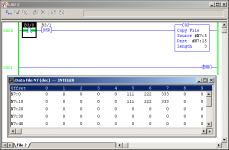SiriusMark
Member
Please clear something up for me. When using the COP command (among others), the length indicates the amount of elements I want to copy, starting at the source. So if I were to use #N7:5 as the source, N7:15 as the destination, and 3 as the length, the command would actually copy N7:5, N7:6, and N7:7 into N7:15, N7:16, and N7:17 respectively. Right?




